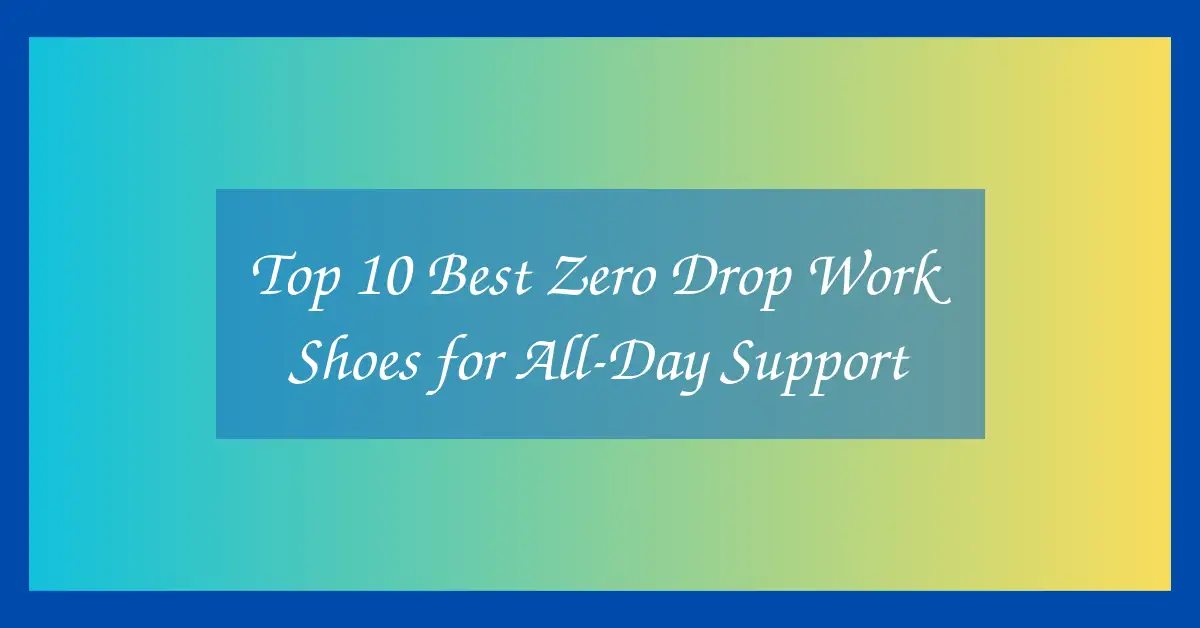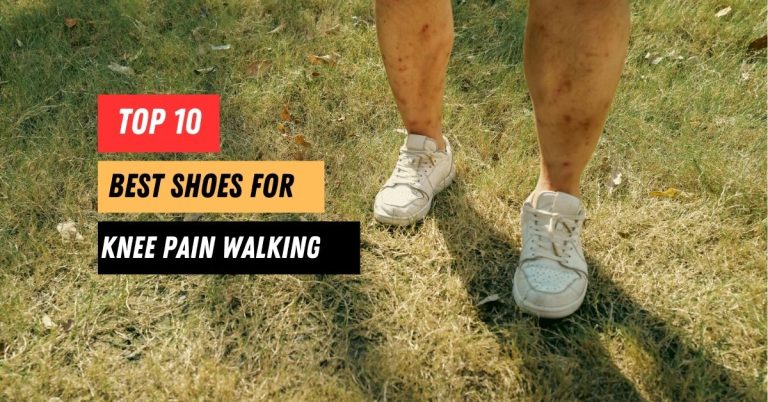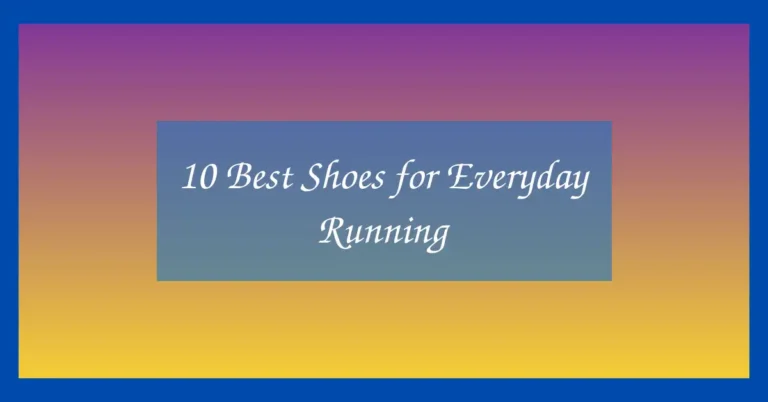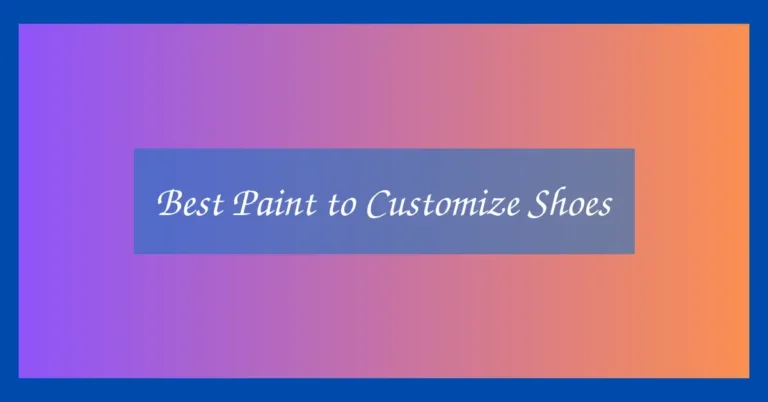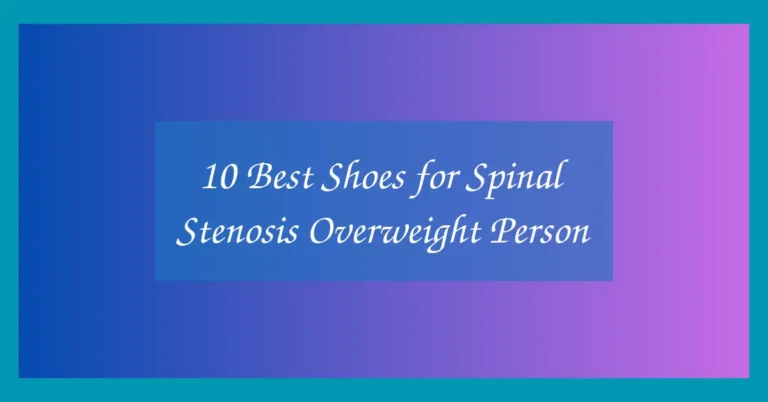Top 10 Best Zero Drop Work Shoes for All-Day Support
Choosing the right footwear for work goes beyond style it’s about protecting your body, maintaining comfort, and staying productive throughout long hours. For many professionals, especially those on their feet all day, zero drop work shoes have become an appealing option. Unlike traditional shoes that elevate the heel, zero drop designs keep your heel and forefoot on the same level. This promotes natural posture, reduces strain on joints, and encourages a more balanced gait. The right zero drop work shoes can mean fewer aches at the end of your shift and improved overall performance. However, not all zero drop shoes are created equal factors like durability, traction, and cushioning can make or break your experience. In this guide, we’ll explore how to choose the best zero drop work shoes and answer common questions to help you make a confident purchase.
Top 10 Best Zero Drop Work Shoes
1. Xero Shoes Prio Work
The Xero Shoes Prio Work is a standout option for professionals seeking a balance between durability and natural foot function. Designed as a versatile work shoe, it combines a slip-resistant outsole with the brand’s signature zero drop profile. This ensures that wearers maintain proper posture while enjoying excellent traction across different workplace conditions. Many users appreciate that this shoe meets ASTM slip-resistance standards, making it suitable for industries such as healthcare, food service, or warehouse work.
Comfort is another strong suit of the Prio Work. It features a wide toe box that allows for natural toe splay, reducing pressure on the forefoot during long shifts. The shoe’s 5.5mm FeelTrue® sole provides ground feedback while still cushioning impact. This promotes foot strength without compromising comfort during extended wear. For professionals who transition between standing, walking, and light physical activity, this balance can be critical.
The upper is made from water-resistant vegan-friendly materials. This not only aligns with sustainable values but also offers practical protection in environments prone to spills. The shoe’s lightweight construction reduces fatigue, especially compared to heavier leather work shoes. Despite the minimalist design, the structure feels supportive enough for demanding shifts.
A key benefit is its adaptability. The Xero Prio Work transitions seamlessly between professional environments and casual settings. You could wear it to work and keep it on afterward without feeling overdressed or uncomfortable. For people who value multi-purpose footwear, this is a real advantage.
However, some wearers note that the minimalist sole may feel too thin on hard concrete floors. For those used to heavily cushioned shoes, the adjustment period can take time. Overall, the Prio Work offers a safe, functional, and sustainable choice for anyone exploring zero drop footwear in the workplace.
Pros:
-
Slip-resistant, ASTM-certified outsole
-
Wide toe box for comfort and natural splay
-
Lightweight and vegan-friendly materials
-
Excellent balance of flexibility and durability
Cons:
-
Minimal cushioning may not suit all-day concrete use
-
Requires transition period for new zero drop users
2. Lems Primal Zen Work
The Lems Primal Zen Work is an evolution of the brand’s popular minimalist shoes, tailored for those who need zero drop footwear that can handle workplace challenges. With its slip-resistant rubber outsole, the shoe offers reliable traction, reducing the risk of slips on slick surfaces. The zero drop platform encourages healthy alignment, helping reduce joint and back strain during long shifts. For professionals who want natural foot mechanics without sacrificing safety, this model strikes a great balance.
Comfort is a defining feature of the Primal Zen Work. It has a generous toe box that provides room for natural movement, minimizing issues like blisters or bunions. The cushioned insole is removable, allowing customization with orthotics if needed. Lems uses air-injected rubber to keep the shoe both lightweight and shock-absorbent, making it a solid option for all-day wear.
The upper is crafted from durable leather with a sleek finish. This makes the Primal Zen Work more formal than many minimalist shoes, making it ideal for office environments or workplaces where polished footwear is expected. The leather is treated for water resistance, ensuring it stands up to occasional spills.
Many users appreciate the shoe’s hybrid appeal it’s suitable for both casual wear and professional use. You could pair it with business casual outfits while still benefiting from zero drop design. The shoe feels natural during movement, avoiding the stiffness often associated with traditional leather work shoes.
On the downside, leather uppers can run warm in hot climates, and the shoe requires occasional care to maintain its appearance. Additionally, while the cushioning is sufficient for most, those working exclusively on concrete floors may need extra insoles for long shifts. Overall, the Lems Primal Zen Work delivers durability, style, and health-focused design.
Pros:
-
Stylish leather upper with professional look
-
Spacious toe box for all-day comfort
-
Lightweight with removable insoles
-
Water-resistant and durable construction
Cons:
-
Leather can run warm in hot climates
-
May need added cushioning for extended concrete use
3. Vivobarefoot Magna Leather FG
The Vivobarefoot Magna Leather FG is a versatile zero drop work shoe designed for those who move between indoor and outdoor environments. Its firm ground outsole provides outstanding grip on uneven terrain, making it suitable for jobs that demand reliable traction. At the same time, the clean leather design ensures it looks professional in an office or service setting. This dual function makes it one of the most adaptable zero drop work shoes on the market.
Comfort is a key strength. The Magna Leather FG features a flexible sole that allows natural foot motion while maintaining enough cushioning to prevent fatigue. The shoe has a wide toe box, a hallmark of Vivobarefoot, ensuring toes can spread naturally. Many professionals find this helps prevent hot spots during long shifts.
Durability is another highlight. The upper is made from Wild Hide leather, sourced from free-roaming cattle, which is both tough and stylish. The material holds up well against scuffs, making it a solid choice for demanding workplaces. The neoprene ankle sock adds extra comfort and helps keep debris out, a useful feature in outdoor work settings.
For sustainability-conscious buyers, Vivobarefoot emphasizes eco-friendly practices, using natural materials and minimal waste in their manufacturing process. This appeals to professionals who value brands that prioritize environmental responsibility.
However, the shoe’s minimalist sole may feel too firm for some, especially if most of your work is on concrete floors. Additionally, the price point is higher compared to other zero drop work shoes, which could be a barrier for budget-conscious buyers. Still, its adaptability across multiple work settings makes it a strong investment.
Pros:
-
Professional leather design with rugged durability
-
Wide toe box and flexible sole
-
Suitable for indoor and outdoor work environments
-
Eco-friendly brand practices
Cons:
-
Higher price point than many alternatives
-
Sole may feel too firm for long hours on concrete
4. Merrell Vapor Glove 6 Work Adapt
Merrell’s Vapor Glove line has long been a favorite among barefoot shoe enthusiasts, and the Work Adapt version is tailored for professionals. With a zero drop Vibram® outsole, this shoe delivers exceptional ground feel while maintaining slip resistance for workplace safety. The thin sole design encourages natural foot mechanics and strengthens muscles over time. For those who value minimalism and safety in one package, the Vapor Glove 6 Work Adapt is a strong contender.
The shoe is incredibly lightweight, reducing fatigue during long hours. Its mesh upper is breathable, making it ideal for hot work environments where foot comfort is often compromised. Despite the thin sole, Merrell adds just enough protection to shield feet from hazards without compromising flexibility. Many wearers report feeling more agile and balanced throughout their shifts.
Durability is another advantage. The Vibram® outsole is known for long-lasting performance and superior grip, even on slick or uneven surfaces. This makes the shoe particularly appealing for warehouse, delivery, or service industry professionals. The reinforced upper withstands abrasion while remaining flexible and lightweight.
The shoe’s design is versatile enough for both professional and casual wear. You can easily transition from the workplace to daily activities without changing footwear. The minimalist aesthetic works well with uniforms and casual outfits alike.
However, the Vapor Glove 6 Work Adapt is not for everyone. Its thin sole provides little cushioning, which can be tough on people who stand exclusively on concrete all day. The shoe also requires a gradual transition period for those new to barefoot or zero drop footwear. For the right wearer, though, it provides unmatched comfort and freedom of movement.
Pros:
-
Lightweight, breathable, and flexible design
-
Vibram® outsole ensures durability and grip
-
Excellent for hot environments
-
Promotes natural foot strength
Cons:
-
Minimal cushioning may be uncomfortable on hard floors
-
Not ideal for those new to barefoot footwear without a transition
5. Altra Provision Work Adapt
Altra is well-known for combining zero drop design with comfort features, and the Provision Work Adapt is an excellent example. Unlike purely minimalist shoes, this model offers more cushioning, making it accessible for those who spend long hours on hard floors. The Balanced Cushioning™ platform keeps the heel and forefoot aligned while reducing stress on joints. For professionals needing zero drop shoes without sacrificing comfort, this strikes a great middle ground.
The Provision Work Adapt features a wide FootShape™ toe box, characteristic of Altra’s design. This ensures natural splay, reducing foot fatigue during extended wear. The shoe’s EGO™ midsole offers responsive cushioning, ideal for those who want more shock absorption than traditional barefoot shoes. This makes it especially appealing to workers in healthcare, retail, or office environments.
Safety is also a focus. The outsole includes slip-resistant rubber designed for wet and oily surfaces. This adds peace of mind for professionals in kitchens, warehouses, or hospitals. The upper combines synthetic overlays with breathable mesh, providing durability without overheating the foot.
Comfort is enhanced further with supportive features like Altra’s GuideRail™ technology, which helps stabilize the foot during long shifts. This is particularly beneficial for individuals prone to overpronation or instability. While it’s not as flexible as minimalist options, it provides more structured support, making it a good choice for transitional users.
On the downside, the shoe is bulkier compared to other zero drop work shoes, and its athletic styling may not fit formal workplaces. Still, it’s a fantastic choice for those who want the health benefits of zero drop without the harshness of barefoot-style soles.
Pros:
-
Zero drop with generous cushioning
-
Wide toe box for comfort and natural splay
-
Slip-resistant outsole for workplace safety
-
GuideRail™ support helps with stability
Cons:
-
Bulkier design than minimalist models
-
Athletic style may not fit all dress codes
6. Xero Shoes 360 Work
The Xero Shoes 360 Work is a performance-oriented zero drop shoe designed for people who need both agility and workplace functionality. Originally built for cross-training, this model adapts well to physically demanding jobs requiring stability, flexibility, and grip. The outsole features a high-traction pattern with additional sidewalls for lateral stability. This makes it particularly effective for jobs where quick movements or lifting are common.
Comfort is an area where the 360 Work excels. Its wide toe box provides freedom for natural toe spread, reducing strain during long shifts. The shoe is lightweight, helping minimize fatigue, and includes a removable insole for those who want either extra cushioning or a closer-to-ground feel. Despite its minimalist design, it offers a level of support that makes it versatile in demanding work settings.
Durability is another strong point. Reinforced upper materials resist wear from frequent bending and impact, while the outsole is engineered for abrasion resistance. This makes it a dependable option for workplaces that put shoes through heavy use. Its vegan-friendly build also appeals to sustainability-conscious professionals.
For active jobs, the shoe’s flexibility allows the foot to move naturally without restriction. Whether crouching, climbing, or lifting, the 360 Work adapts to dynamic movements. This sets it apart from stiffer leather work shoes, which can feel restrictive in comparison.
However, the minimalist cushioning may not suit workers who spend all day on hard surfaces. Additionally, while functional in active settings, it lacks the polished look of leather models, which limits its appeal in formal workplaces. Still, it’s an excellent choice for professionals in warehouses, gyms, or trade environments.
Pros:
-
Excellent lateral stability and traction
-
Wide toe box for comfort
-
Durable and vegan-friendly construction
-
Lightweight with removable insole
Cons:
-
Minimal cushioning on concrete
-
Less formal appearance than leather models
7. Lems Boulder Boot Work
The Lems Boulder Boot Work is a rugged zero drop option for professionals who need protective footwear in outdoor or industrial environments. Its zero drop platform promotes balanced posture, while the boot design provides ankle support and stability. The lightweight build sets it apart from traditional work boots, which often feel heavy after long hours.
One of its standout features is the wide toe box. This ensures natural toe splay, which is especially beneficial during extended standing or walking. The cushioning is moderate, striking a balance between barefoot-style flexibility and comfort for all-day wear. Many users appreciate that it doesn’t feel overly bulky despite being a boot.
Durability is a key advantage. The Boulder Boot Work is crafted from tough leather uppers and rugged outsoles that withstand daily wear. Its slip-resistant sole makes it suitable for wet or uneven ground, a critical factor in job sites or outdoor work. At the same time, the flexible sole allows the foot to move naturally, reducing fatigue.
Comfort extends beyond just cushioning. The boot’s lightweight construction reduces leg strain compared to traditional heavy-duty boots. The leather upper is water-resistant, offering protection against spills or damp environments. With a casual, versatile design, the Boulder Boot Work can transition from job sites to casual settings seamlessly.
However, leather boots generally require a break-in period, and the Boulder Boot Work is no exception. Some users may also find it too casual for highly formal workplace environments. Overall, it’s an excellent zero drop work boot for those who want rugged durability without the excess weight of traditional designs.
Pros:
-
Lightweight boot with zero drop platform
-
Wide toe box for comfort
-
Durable leather and slip-resistant outsole
-
Water-resistant and flexible design
Cons:
-
Requires break-in period
-
Style may not fit formal workplaces
8. Bearfoot Ursus Work Trainer
The Bearfoot Ursus Work Trainer is designed specifically for professionals who want to maintain natural foot mechanics while benefiting from protective footwear. Known for its barefoot-style flexibility, this shoe provides a true zero drop experience while still accommodating the demands of the workplace. Its minimalist design promotes balance and foot strength.
The wide toe box allows for natural splay, which reduces fatigue during long shifts. The shoe is crafted with a flexible sole that encourages natural gait while maintaining sufficient grip. This makes it suitable for indoor jobs requiring movement across slick or hard floors. Many wearers find the Ursus Work Trainer helps reduce discomfort associated with traditional shoes.
Durability is built into the design. Reinforced materials and sturdy outsoles extend the shoe’s lifespan, even in demanding environments. The breathable upper ensures comfort in warm conditions, preventing overheating and excessive sweating. For workplaces where hygiene is a concern, the shoe’s removable insoles make cleaning simple.
A major advantage is how lightweight the Ursus Work Trainer feels. This reduces overall fatigue and allows professionals to move more freely. Its minimalist design also helps strengthen foot muscles over time, making it appealing for those committed to long-term foot health.
On the downside, the lack of significant cushioning may not be ideal for professionals who spend entire shifts on unforgiving surfaces. It also has a casual aesthetic that may not suit corporate or formal workplaces. Still, for industries prioritizing mobility and comfort, the Ursus Work Trainer is an excellent option.
Pros:
-
True minimalist zero drop design
-
Wide toe box supports natural movement
-
Breathable and lightweight
-
Durable with removable insoles
Cons:
-
Minimal cushioning may be tough on concrete
-
Casual look not suitable for formal settings
9. Freet Tundra Work Shoe
The Freet Tundra Work Shoe blends barefoot principles with workplace functionality. Its zero drop platform supports natural alignment while providing durability and traction. Designed with versatility in mind, the Tundra works well both indoors and outdoors, making it appealing for professionals who need reliable shoes across varied environments.
The shoe’s wide toe box and flexible sole promote comfort during long hours of wear. Unlike many minimalist shoes, the Tundra offers a moderate level of cushioning, making it more accessible for those transitioning to zero drop footwear. Many wearers note that it feels less harsh than ultra-minimalist models while still maintaining a barefoot-like experience.
Durability is a defining feature. The shoe is constructed from durable synthetic materials that resist wear, with an outsole built for traction on slippery or uneven surfaces. This makes it suitable for both service industry jobs and outdoor tasks. The water-resistant upper also adds a layer of practicality.
Comfort is further enhanced by the breathable upper and lightweight design. These features make it easier to stay active throughout the day without experiencing excessive fatigue. The Tundra’s removable insoles allow for customization, giving users the choice between extra cushioning or a closer-to-ground feel.
While the Tundra offers versatility, it isn’t as sleek or polished as leather options, making it less suitable for formal office settings. Additionally, its price point is on the higher end compared to some competitors. However, for workers needing durability, traction, and natural foot mechanics, the Tundra is a reliable investment.
Pros:
-
Flexible, breathable, and lightweight design
-
Moderate cushioning suitable for transitions
-
Durable, water-resistant materials
-
Wide toe box supports comfort
Cons:
-
Less formal appearance
-
Higher price compared to other options
10. Softstar Primal Professional Work Shoe
The Softstar Primal Professional Work Shoe is a unique option blending zero drop functionality with a professional aesthetic. Handcrafted in the USA, it’s designed to meet the needs of professionals who want barefoot-style benefits in a workplace-friendly package. The zero drop sole promotes natural posture, while the minimalist build supports healthy foot function.
Comfort is one of its strongest features. The shoe boasts a wide toe box that prevents pinching and allows natural movement. Its flexible Vibram® sole provides ground feedback while still offering enough cushioning for long workdays. Many professionals find the Primal Professional ideal for all-day wear in office environments.
Durability is ensured through the use of premium leather. This not only looks polished but also withstands daily wear. The shoe’s minimalist design is lightweight, reducing fatigue, while the leather adds sophistication suitable for corporate or formal workplaces.
Another advantage is customization. Softstar offers different width and size options, allowing wearers to get a more tailored fit. For professionals struggling to find properly fitting footwear, this is a major benefit. The handmade construction also appeals to buyers who value craftsmanship and sustainable production.
On the downside, leather requires regular maintenance to preserve its polished look, and the shoe comes with a premium price tag. Additionally, its minimalist cushioning may not be ideal for workers on hard concrete all day. Still, for office and professional environments, the Primal Professional is a standout option for combining barefoot design with workplace polish.
Pros:
-
Professional leather aesthetic suitable for offices
-
Wide toe box and flexible Vibram® sole
-
Lightweight and handcrafted in the USA
-
Customizable fit with width options
Cons:
-
Requires regular leather maintenance
-
Premium price point
-
Minimal cushioning for hard floors
Buyer’s Guide
When selecting the best zero drop work shoes, it’s important to balance the health benefits of a natural foot position with the demands of your workplace. Below are key factors to consider:
1. Durability
Work shoes must withstand constant wear and exposure to different environments. Look for reinforced stitching, abrasion-resistant uppers, and sturdy midsoles. Leather or high-quality synthetics often provide the longest lifespan. If your work involves exposure to oil, chemicals, or rough terrain, durability becomes even more essential. A zero drop shoe with poor durability may compromise foot protection and cost more in frequent replacements.
2. Grip and Traction
Workplaces can be unpredictable slippery floors in a warehouse, wet concrete outdoors, or slick office tiles. Reliable grip is critical to safety. Outsoles with deep lugs or slip-resistant rubber provide better traction. If you’re in a service industry like food or healthcare, non-slip certification (ASTM or OSHA standards) is a smart consideration. For outdoor work, prioritize rugged tread patterns designed to handle uneven ground.
3. Comfort and Cushioning
Zero drop shoes encourage natural movement, but that doesn’t mean they should feel harsh on your feet. The best options strike a balance between minimal heel-to-toe drop and enough cushioning to absorb shock during long shifts. Memory foam insoles, EVA midsoles, or removable inserts for custom orthotics can add lasting comfort. Pay close attention to arch support—some zero drop shoes provide more structured support, while others allow your foot to strengthen naturally.
4. Materials and Breathability
Materials greatly influence comfort. Leather offers durability and weather resistance but can run warm. Mesh or knit uppers provide breathability for hot environments but may be less protective. Hybrid materials can deliver the best of both worlds. For workplaces where hygiene is crucial, antimicrobial linings or moisture-wicking fabrics help keep feet dry and odor-free.
5. Fit and Toe Box Width
A roomy toe box is often associated with zero drop shoes, giving toes space to splay naturally. This prevents discomfort and blisters, especially during extended wear. Always check sizing guides since some brands run narrow, which can undermine the benefits of a zero drop design.
6. What to Avoid
Avoid overly stiff soles that restrict movement, as they defeat the purpose of zero drop footwear. Also steer clear of cheaply made shoes with thin outsoles that wear down quickly these can compromise stability and safety at work. Finally, don’t jump straight into long shifts with brand-new zero drop shoes. Transition gradually to let your muscles adapt.
By weighing these factors, you can find zero drop work shoes that provide safety, durability, and all-day comfort while encouraging healthier foot mechanics.
FAQ
1. What are zero drop work shoes, and how do they differ from regular shoes?
Zero drop shoes have no height difference between the heel and forefoot, unlike traditional shoes that elevate the heel. This design promotes a more natural walking pattern, encourages better posture, and reduces strain on the lower back and knees. For work environments, the zero drop design can mean less fatigue after long hours of standing or walking.
2. Are zero drop shoes suitable for all-day wear at work?
Yes, but with a caveat. If you’re new to zero drop footwear, your calves and feet may need time to adjust. Start by wearing them for a few hours a day before committing to full shifts. Once your body adapts, many wearers find them more comfortable for prolonged standing than traditional shoes.
3. Do zero drop work shoes provide enough arch support?
It depends on the brand and model. Some zero drop shoes are minimalist, offering little built-in support, while others feature structured insoles. If you need extra arch support, choose models with removable insoles so you can insert custom orthotics. This ensures comfort without sacrificing the benefits of zero drop design.
4. Are zero drop work shoes safe for slippery work environments?
Yes if you choose the right outsole. Many zero drop shoes designed for work feature slip-resistant rubber, oil resistance, and tread patterns that grip wet or uneven surfaces. Always check if the shoes meet industry safety standards before purchasing for high-risk workplaces.
5. How do I transition to zero drop shoes if I’ve always worn traditional shoes?
Transition slowly. Start with one to two hours of wear per day, gradually increasing time as your muscles strengthen. Doing foot and calf stretches can also ease the adjustment period. Jumping directly into a full shift may cause soreness or strain, especially in the calves and Achilles tendon.
6. Can zero drop work shoes help with back or joint pain?
For many wearers, yes. By aligning the body in a more natural posture, zero drop shoes may reduce pressure on the lower back, knees, and hips. However, they’re not a cure-all. If you have chronic pain or medical conditions, consult a podiatrist to see if zero drop shoes are appropriate for your situation.
7. What’s the best way to care for zero drop work shoes?
Care depends on the material. For leather, use conditioner and water-repellent sprays. For mesh or fabric, regular cleaning with mild soap helps maintain breathability. Rotate between pairs if possible, as this prolongs lifespan and ensures shoes dry fully between uses. Always follow the manufacturer’s care instructions for best results.
Conclusion
Choosing the best zero drop work shoes is about more than comfort it’s about safety, performance, and long-term health. The right pair promotes natural movement, reduces fatigue, and adapts to workplace demands. Whether you need durability, slip resistance, or professional styling, these shoes provide options for every environment, ensuring all-day functionality without sacrificing the benefits of zero drop design.

